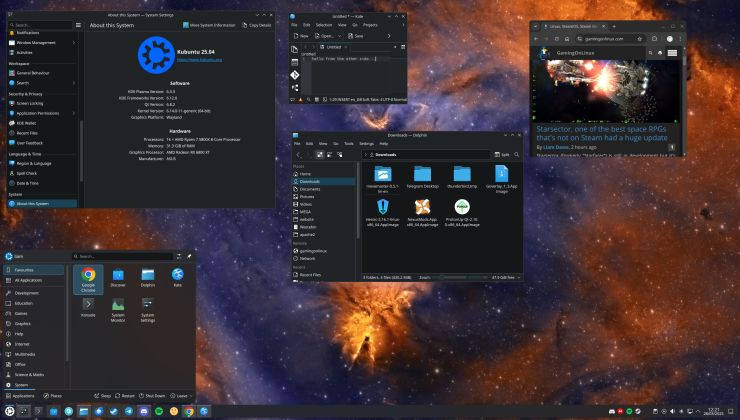Announced earlier this month, the Orange Pi Neo is a gaming handheld coming out a bit like the Steam Deck but it will be running Manjaro Linux. Recently the Manjaro team gave out a bit more info that was all in a Q&A post on the official Manjaro forum.
This isn't something that was rushed as Manjaro project lead Phillip Müller noted they've worked with Orange Pi on this since May 2023, and the Neo will be released with the first version of Manjaro that's immutable (just like SteamOS on the Steam Deck) named Manjaro Gaming Edition. This will come with special patched versions of gamescope, handygccs, OpenGamepadUI, hhd and it will have a focus on Flatpaks for extras. It will also ship with the KDE Plasma desktop mode, just like the Steam Deck again. So overall how it will work should be very close to SteamOS.
Something many people have been asking for: more handhelds that match up to the software experience on the Steam Deck and not just sticking something on top of Windows to make it slightly less terrible. The thumbpads and an extra USB port are also very welcome.
What they're currently working on getting working:
- RGB control still needs to be added to hhd or a dedicated application.
- TDP control might work via OpenGamepadUI overlay mode.
- controller support still needs to be added to OpenGamepadUI.
- fan curves and battery control needs to be optimized.
- Audio Equalizer might still need some work to improve audio quality.
- Standby and Sleep needs some work in software and firmware to properly work.
They even noted the gyroscope model as a BOSCH 260, which is already supported.
Most importantly: what about pricing and release date? Well the good news on both is that it's not far away with a Q2 2024 target (April - June), and they say the price is aiming for the lower-end of Steam Deck pricing so it sounds like it's going to be really competitive there.
Here's a reminder of the specs:
| Screen | 7-inch FHD+ (1920 x 1200, WUXGA) 16:10, 500nits Brightness, 120Hz Refresh Rate |
| RAM | 16GB/32GB LPDDR5 (6400MHz dual channel) |
| Dimensions | 259mm*107mm*19.9mm |
| Triggers | Linear Hall Trigger |
| Ports | 2x USB 4.0 Type-C, 1x 3.5mm headphone jack, 1x TF card slot |
| BT / WiFI | BT5.3, Wifi 6E |
| Cooling | Turbo Large Fan, Dual Copper Pipes + Aluminium Alloy Cooling Fans, extra large air vents + customised cooling system and air ducts with a subtle design |
| Colour | White/Black |
| CPU | AMD Ryzen 7 7840U |
| Storage | 512GB-2TB PCIe 4.0 NVMe M.2 SSD (2280) |
| Battery | 50WHrs, 3S1P, 3-cell Li-polymer battery |
| Joysticks | Hall Sensing Joystick with RGB Lighting |
| Gyro | Dual 6-axis gyroscopes |
| Audio | 2x 1W dual panoramic speakers |
Really keen to see more from this! What do you think?
See more in the Q&A post. Additionally there's also the Manjaro Gaming Slimbook laptop recently launched.
However it will be at the lower end of Steamdeck pricing.
How though? Every other 7840u handheld is miles off even the highest end Steam Deck price, even considering early bird indigogo discounts. The big players like Asus and Lenovo can't get close either.
I haven't heard good things about Manjaro, but this is the most promising Deck alternative I've heard of yet.Haven't heard good things about Manjaro? I've been using it for a few years and have nothing but good things to say about it.
Last edited by Mountain Man on 17 Feb 2024 at 2:59 pm UTC
1- ability to permanently disable rgb everywhere
2- ability to sleep/suspend and resume in the middle of a game same as the Deck does
Both of those are listed in the article as "currently working on" so that's great! As long as those are ticked off, then this will be a VERY interesting Deck competitor. Going to keep my eye on it for sure.
SCUF patent
Out of the loop, what's the SCUF patent?
From my understanding, Basically, one of the reasons that valve isn't selling steam controllers anymore, and are if I'm not mistaken currently in a patent lawsuit with SCUF over having back paddles in the controller, is because SCUF have been known to patent troll people a lot, and this is why back paddles in control schemes are not yet standardized, [since they own a patent on "Rear-side control surfaces". ](https://www.polygon.com/2021/2/3/22264213/valve-steam-controller-lawsuit-scuf-4-million)







 How to set, change and reset your SteamOS / Steam Deck desktop sudo password
How to set, change and reset your SteamOS / Steam Deck desktop sudo password How to set up Decky Loader on Steam Deck / SteamOS for easy plugins
How to set up Decky Loader on Steam Deck / SteamOS for easy plugins
See more from me